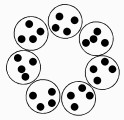| Sat-gol |
| Other Names: Satgol |
| First Description: Hem Chandra Das Gupta, 1926 |
| Cycles: One |
| Ranks: One (Circle) |
| Sowing: Pussa Kanawa |
| Region: India |
Sat-gol was described by Professor Hem Chandra Das Gupta. He was the first Indian full-time Professor of Geology at Presidency College, Founder of Geological, Mining and Metallurgical Society and Geological Institute.
The information about Sat-Gol comes from the village of Gosalpur, in the Jabalpur district, Madhya Praddesh (India).
No cultural background of this mancala game was given.
Rules
The board is made of seven circles arranged in a circle.
At the beginning, there are four stones in each circle.
Initial Position
On your turn a player takes all the pieces from any circle and sows anticlockwise one into each circle. When he has sown all the pieces in his hand, he takes those of the next circle and sows them.
The turn ends when the last stone is dropped in a circle which is followed by an empty one.
If the empty circle is followed by an occupied one, its contents are captured.
According to the original description it is not permitted to choose the hole from which the move begins. One must take the first non-empty hole after the hole where the opponent finished his last move. This would lead to a single game that would be played exactly the same all the time. Víktor Bautista i Roca therefore suggested:
- You can choose from which hole the sowing is started.
- The game ends when both players agree that it is impossible to capture more pieces and the remaining stones are not counted.
Murray misunderstood Das Gupta's description, writing that "the player captures the contents of the hole beyond, or if there is a sequence of empty holes, the contents of the first loaded hole". Das Gupta, however, stated: "[The move] continues until the player drops his last piece within a circle next to which there is an empty one and then he will be in possession of the pieces lying within the circle immediately next to the latter".
The player who captures more pieces wins the game.
References
- Das Gupta, H. C.
- A Few Types of Sedentary Games Prevalent in the Central Provinces. In: Journal of the Asiatic Society of Bengal 1926; 22 (New Series): 211-213. (Republished in: Ray, N. & Ghosh, A. (Ed.) Sedentary Games of India. The Asiatic Society, Calcutta (India) 1999, 84-85.)
- Murray, H. J. R.
- A History of Board-Games Other Than Chess. Oxford (UK) 1951, 170.
Copyright
© Wikimanqala.
By: Víktor Bautista i Roca
Under the CC by-sa 2.5 license.
